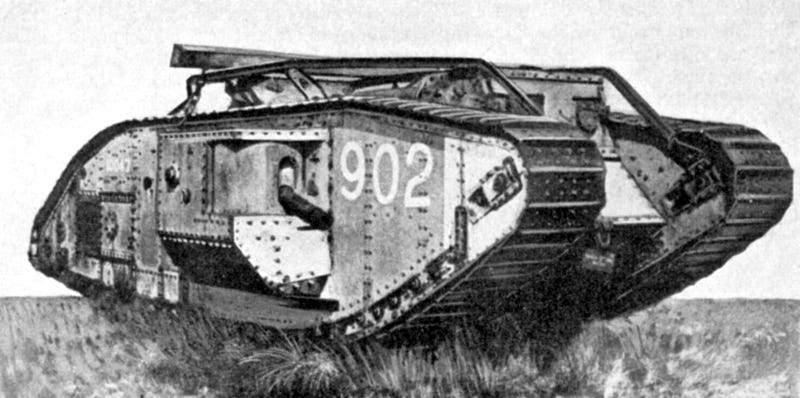FULL FEATURE: A Tank Battalion Attacks (with Canadians), 1918
This week I’ve jumped back into my tank memorial book, which compiled hundreds of medal citations from 1916-18. Last time, I looked at a random selection of brave deeds by the ordinary rank and file. You can read that here:
This time, I’m picking one attack, and one battalion, which has a lot of citations for the events in question, and putting the statements about individual men into context with the battle raging around them. I’ve gone that granular that I’ve made my eyes bleed. But I think it’s worth it, so here we go…
A British Mark V tank (Wikipedia)
8th August 1918 is known as a black day for the German Army. In Brit-centric circles, it marks the beginning of the Battle of Amiens and of the 100 Days to victory and the crushing of the German Army on the Western Front. You’ll not be surprised to learn that I have a different version of this glory-hogging story that bangs on about on the French more, but this date was a big deal, that much is certainly true. By this time, Ferdinand Foch was in overall command of the Allies, and having slammed the enemy successfully with a counter-offensive on the Marne, he now proposed to launch an offensive.
The Battle of Amiens saw nearly 50 Allied Divisions; British, French (at Foch’s insistence) and some supporting Americans launch themselves at a vastly outnumbered enemy. The principle was to push back away from the city of Amiens, to which the British had been pushed back during the German spring offensives. Rawlinson’s Fourth Army sent in a British Corps north of the River Somme and another of Australians to the south of the river. Our tank story involves the Canadians, who were moved up en masse to participate in this battle without being noticed by the enemy. They were only in position on 7th August, and would be attacking to the south of the Australians. To their right were the French.
Zooming in, the 4th Tank Battalion was allocated to the middle of the front covered by the 1st Canadian Division. The need for secrecy had been rammed home repeatedly. Tank commanders were ordered to keep themselves concealed until the last possible moment, and marked on their maps were notes on hostile artillery batteries. They were, of course, supposed to reconnoitre their areas, but an order on this and the secrecy required was sent out on 4th August and pointedly said of reconnaissance:
This will be carried out as unostentatiously as possible. Parties must be cut down to the lowest possible number; they will in no case exceed two persons.
Known observation posts. will be avoided. A list of positions from which a good general view is obtainable has been issued to battalions.
Everyone must realise that an increase in movement in forward areas, especially of officers, is a recognised indication to the enemy that some operation is pending: Reconnoitring parties will therefore avoid exposing themselves in every way possible. Trenches will invariably be used over ground under observation, and care taken not to display maps in the forward area.
3. Commanding Officers will ensure that the number of Officers reconnoitring the enemy’s positions is limited to those for whom such reconnaissance is essential.
This all had an impact on preparations for the tanks:
‘Reconnaissance of rear and forward areas carried out before the operations was of necessity very hurried, only six days being available for the making of all preparations for the approach march and final assembly, as well as for the actual battle.’
They obeyed the instructions for restricting who went forward, but they did manage to glean valuable information:
‘All Tank and Section Commanders, however, were able to obtain at least one good view of their battlefield from selected rear o.p’s. as well as the necessary Instruction on their routes from Company Reconnaissance Officers. Good landmarks were abundant, and the oblique photographs supplied by the French Flying Corps admirable and of the greatest value. The special [map] sheet produced for the battle was extremely accurate and very clear…
It is worthy of note that… no tanks lost their way either during the whole of the first day’s operations, or during those of subsequent days when reconnaissance was even more hurried that it had been before Zero Hour on 8th August.’
The battalion’s 42 tanks would be going in at the onset; 4:20am on 8th August, and aiming to get all the way through the the infantry’s final objectives which constituted a blue line drawn across the sector between the Amiens-Roye road and the Amiens-Chaulnes railway. The tanks were to proceed in front of the infantry, and “break up any hostile opposition which was not dealt with by the artillery barrage.’ So that’s where our guys were supposed to be, and what they were supposed to be doing. So how did it pan out? Rather successfully, as it happens…
Keep reading with a 7-day free trial
Subscribe to Alex Churchill’s HistoryStack to keep reading this post and get 7 days of free access to the full post archives.



